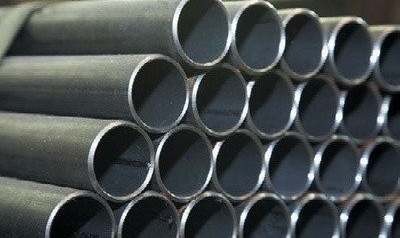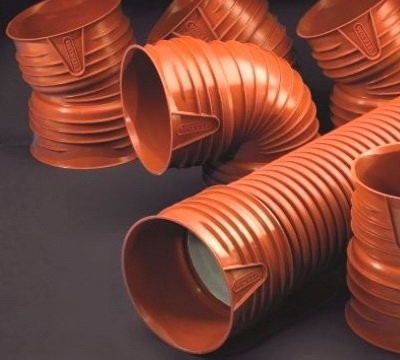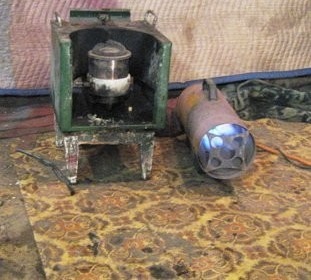Which pipes are best to choose for heating: a comparative overview of 6 options
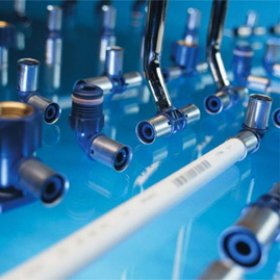
A person seeks comfort in everything, especially in his home. A necessary condition without which the house cannot be considered convenient for living is heat. After all, even the most beautiful designer interior in a cold damp room will not please its owner. That is why the question of which pipes for heating is better excites everyone who begins to finish or repair their homes. Modern industry offers several options for solving this issue. Various pipes are designed for equipping the heating system. Which ones to prefer? Let's get it right.
For a competent choice, you need to analyze many factors. The characteristics of certain types of pipes must necessarily be considered regarding the possibility of their use in a particular heating system. When choosing a pipe type, you must consider
- Power pressure system.
- Pipeline mounting method: external or internal.
- Type of heating system: gravity or forced.
- Maximum coolant temperature.
- A system configuration that can be complex or simple.
Only with these factors in mind can you choose the right type of heating pipe. Consider the most common of them.
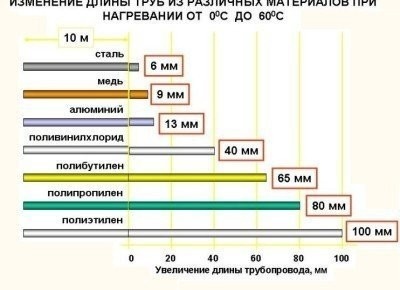
When designing and installing a pipeline, many parameters must be considered. For example, the coefficient of linear elongation of the pipe during heating
Traditionally, heating system pipelines were made of metal. Today you can choose from several options for metal products.
Content
Option # 1 - ferrous metal parts
Not so long ago, steel pipes were almost no alternative for the vast majority of heating systems. Today they continue to be used. Steel works especially well in autonomous gravity systems where large diameter pipes are needed. The advantages of such pipes include:
- high thermal conductivity;
- slight linear expansion;
- resistance to high pressure;
- strength;
- ability to withstand high temperatures;
- affordable cost.
Among the shortcomings, it is worth paying attention to the complex installation, which is impossible without the use of special equipment. Only a person with the necessary training can work with him.
The dimensions of the pipes also complicate the installation process. It is best carried out before starting the finishing work, since welding can damage the floor and wall coverings very easily.Another “minus” - the metal is susceptible to corrosion, which is why it is not recommended to use it for laying hidden pipelines.
Option # 2 - copper products
Such pipes are considered an exclusive option and are not widely used. The advantages of the material include:
- Wide range of operating temperatures. Copper can transport a coolant heated to 500C, and can withstand the freezing of the system without loss.
- High pressure resistance, including water hammer.
- Long service life, which reaches 100 years.
- The special appearance of the pipeline. Over the years, it is covered with a noble patina, which gives it a special chic.
The only drawback of copper is its very high cost, which affects the prevalence of such parts.
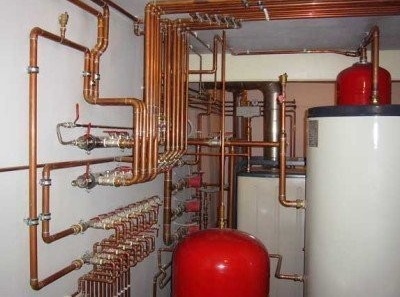
The correct selection of the diameter of the pipe for heating is very important, especially when working with copper pipes
A little information about the features of installing such a pipeline:
Option # 3 - Stainless Steel Pipes
Stainless steel products are a great alternative to copper products. They are distinguished by:
- Resistance to high pressure, especially this indicator is high for seamless thick-walled pipes.
- Long service life.
- High thermal conductivity.
- Possibility of transporting coolant heated to high temperatures. Up to superheated steam.
- Mechanical strength.
- Lower cost in comparison with copper.
Two versions of stainless steel pipe are available: with a weld and seamless. The first are made by welding a sheet of steel. They have a lower price, but at the same time have a shorter service life. The best are seamless products, thin-walled models of which can be considered almost an analogue of copper pipes.
Option # 4 - polypropylene piping
Plastics appeared relatively recently, but very quickly conquered the market of building materials due to its diverse properties. For heating systems, several types of plastic pipes can be used. Polypropylene pipelines are among the practical budget systems. Their main advantages are:
- Light weight, not giving additional load on the structure, and facilitating the installation of the system.
- Long service life averaging 25 years.
- A smooth inner surface that does not allow lime deposits to accumulate inside the pipe.
- High resistance to freezing temperatures.
- Attractive appearance.
For the installation of polypropylene elements, special equipment is used, the so-called soldering iron. The simplicity of its use allows even an untrained person to mount such a pipeline without any problems. However, the material also has drawbacks. Low stiffness of the plastic leads to sagging lines, which can cause breakage.
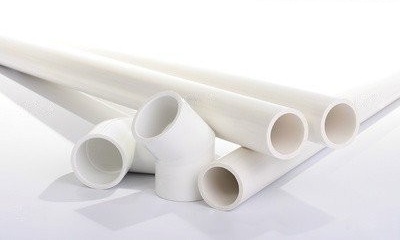
Polypropylene pipes are very easy to install, practical and durable. However, they can be used only taking into account the fact that the products can transport a coolant whose temperature does not exceed 70C
Polypropylene does not bend, so you have to use special fittings to make turns and bends. It must be borne in mind that if pipe repair is necessary, the entire fragment located between the two fittings belongs to the replacement. The main disadvantage is low heat resistance. Polypropylene pipes are designed for transporting a coolant whose temperature is not higher than 70 ° C. Therefore, their use is limited.
Option # 5 - Crosslinked Polyethylene
Cross-linked polyethylene pipe is a novelty of precast technologies. However, she has already managed to gain popularity among developers. This is due to its undoubted advantages:
- The special density of the material, which gives it resistance to elevated temperature and high pressure.
- The effect of memory, which consists in “remembering” an element of the position that is given to it. When heated, the pipe straightens. This quality greatly simplifies installation.
- A smooth surface inside the product, on which deposits are not fixed, and the lumen of the pipe is not tightened.
- Low coefficient of expansion and corrosion resistance, which allows for concealed installation of products.
- Long service life of more than 50 years, according to the claims of manufacturers.
- Easy installation. Thanks to the use of special press fittings, it can be carried out without the use of special equipment.
Among the disadvantages of pipes made of cross-linked polyethylene is the instability to the effects of UV radiation, which destroys the material. In addition, the technological features of the production of such products do not allow the production of pipes of large diameters.
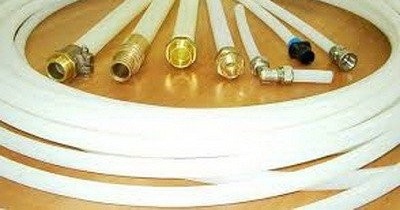
According to the manufacturer's assurances, the service life of cross-linked polyethylene pipes is at least fifty years
Option # 6 - metal-plastic products
According to statistics, plastic pipes are most often chosen for arranging a heating system. They successfully combine the advantages of plastic and metal. The special design and complex multilayer structure of the pipe determine the numerous advantages of such products.
The outer layer is made of plastic that protects the product from adverse effects. Below it are layers consisting of aluminum foil and a special smooth polymer that prevents deposits. Using a special adhesive allows you to securely fasten all layers, resulting in a very durable and ductile material. The advantages of metal-plastic products include:
- A wide range of applications.
- A small linear expansion that does not give the effect of "sagging" of the pipeline.
- Smooth inner surface preventing pipe clogging.
- Simple installation without the use of special equipment.
- Temperature resistance is higher than other plastic products, but lower than metal products.
- Light weight.
- Higher strength than plastic parts.
- Excellent ductility, however, if the permissible bending radii are exceeded, the part can be “wound".
- The material is not subject to corrosion.
The disadvantages include a relatively short service life of about 15 years and a rather high cost of metal-plastic pipelines. The final price of the arrangement of the system also includes the cost of fittings, which makes the amount even higher. The joints of such parts are considered less reliable, especially if we consider the joints with compression fittings that require additional maintenance. In addition, when the system freezes, the brass fittings may burst and the pipe will become unusable.
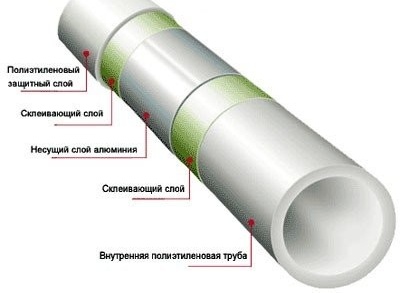
The complex structure of the metal-plastic pipe determines its multiple advantages. The layers of plastic and metal reliably adhere to each other, forming a durable and plastic part
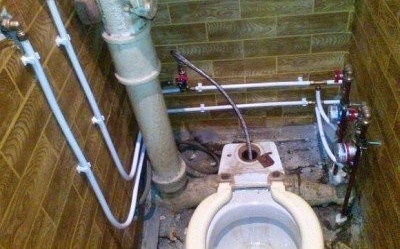
Plastic pipes can be either bent or connected using fittings. But it is necessary to bend using a pipe bender, otherwise the pipe can be broken
It is unambiguous to answer which pipes it is impossible to choose for heating. The decision is made by each developer independently, taking into account the features of his heating system. It should be noted that it is not worth making a choice only from the perspective of false savings and buying the cheapest pipes. The seemingly most attractive “budget” option may turn out to be of low quality. And then constant repair work can very quickly turn it from cheap to truly “golden”. It is much more profitable to pay once for high quality and not to think about possible problems with heating for many years.
